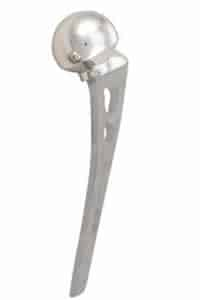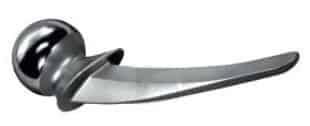
Partial hip replacement implants are used most commonly to treat a fractured hip in an older patient, rather than a hip damaged by osteoarthritis, for which total hip replacement is a treatment.1 It is usually an emergency surgery made necessary from a fall or other accident fracturing the hip. Partial hip replacement surgery is more properly known as ‘hemiarthroplasty’, or ‘hemi’, meaning ‘half a joint’ because it replaces only the ball portion of the hip joint, not the socket portion. A total hip replacement implant, by contrast, replaces both the ball and socket of your hip joint.
More about Partial Hip vs Total Hip Replacement >>
More than 270,000 hip fractures occur in the United States each year, with about 90% occurring in people older than 60.2 The most common reason older people fracture their hips is that they are frail and not in good health. Their bones may be brittle due to osteoporosis, or they may be unsteady on their feet and more likely to trip and/or stumble. It is theorized that sometimes an elderly person’s hip bone may become so weak it can actually give way, causing them to fall, rather than the fall causing the break in their hip.
The treatment of hip fractures is dictated by the classification of the fracture and the viability of the head of the femur (See: Appendix A). Your surgeon will determine if your fractured hip can be repaired, or if your state of health and expected longevity qualifies you for a partial hip replacement, or if other factors such as advanced osteoporosis necessitates the need for a total hip replacement.3
Partial Hip Implants
Unlike total hip replacement implants which have a separate stem and ball, the classic partial hip replacement implants pioneered in the 1960’s and still used today incorporate a complete stem and ball design. The unipolar design features a solid metal ball and stem that replaces the femoral head and upper femur (thigh bone). The Austin Moore and Thompson prosthesis are common examples of the unipolar design, where hip movement occurs directly between the prosthesis and the acetabulum (hip socket). Other more recently developed partial hip replacement implants are modular, allowing different combinations of stem, neck length, and head.
The unipolar and modular devices are unique to partial hip replacement procedures and would not be considered as treatment for an arthritic hip, which requires a total hip replacement.
- an Austin Moore implant which is used without cement (the bone grows through the holes)

- a Thompson prosthesis which is generally affixed with bone cement

- a modular prosthesis with a separate ball head

Like total hip replacement implants, partial hip replacement implants come in cemented and cementless versions. Meaning, the implant can be affixed into position either with the use of bone cement, or without. One of the drawbacks of cementless fixation is risk of instability and loosening due to potential poor bone quality in older and elderly patients.4
The Procedure & Recovery
Similar to a total hip replacement, the femoral head of your upper thigh bone is removed and the shaft reamed out to accept the stem of the partial implant. The device is inserted, and the surgical opening closed, usually with vacuum drains to remove any excess blood drainage.
Recovery may be difficult if you are elderly and in poor general health. Many patients do manage to get back to a good quality of life, however about as many also end up requiring long term care in one form or another due to compounded age and health related issues.
Overall, partial hip replacement is less complex an operation than total hip replacement, and provides generally satisfactory results for less active elderly patients with a lower life expectancy. In the case of more active older patients with a longer life expectancy, a total hip replacement is favored for displaced femoral neck fractures.5
More about partial hip replacement surgery >>
Appendix A
Classifications of fractured neck of femur (Fig. 1)

- Classification 1: subcapital fracture
- Classification 2: fracture of the neck of femur
- Classification 3: intertrochanteric fracture
- Classification 4: subtrochanteric fracture (also called an upper third fracture of the shaft
Only subcapital fractures are likely to require hemiarthroplasty depending upon the grade classification
Grades of subcapital fracture (Fig. 2)
- Grade I: partial subcapital fracture
- Grade II: undisplaced subcapital fracture
- Grade III: partially displaced subcapital fracture
- Grade IV: displaced subcapital fracture

There are various methods of dealing with a subcapital fracture of the femur. First depends upon the grade and the upon the viability of the blood supply to the head.
- In Grade I the blood supply is intact, can be pinned and will heal successfully.
- In Grade II, though the blood supply is severed, there is every chance the head may yet survive and the bone heal. However, if there is evidence on the xray that the bone in the head is failing, then a hemiarthroplasty will be necessary.
- In Grade III, if the head is still viable (not showing signs of bone death) and the fracture can be reduced (put back together) then it may be pinned but the chances are that a hemiarthroplasty will be necessary.
- In Grade IV a hemiarhroplasty will always be required.
Sources
- eorthopod.com, “A Patient’s Guide to Hemiarthroplasty of the Hip” https://www.eorthopod.com/content/hemiarthroplasty-hip
- The Merck Manual, “Hip Fractures” https://www.merckmanuals.com/home/injuries_and_poisoning/fractures/hip_fractures.html
- Mihra S. Taljanovic, MD, Marci D. Jones, MD, Tim B. Hunter, MD, James B. Benjamin, MD, John T. Ruth, MD, Andrew W. Brown, MD and Joseph E. Sheppard, MD. “Joint Arthroplasties and Prostheses” https://radiographics.rsna.org/content/23/5/1295.long
- Yusuf Öztürkmen, Mahmut Karamehmetoğlu, Mustafa Caniklioğlu, Yener İnce, and İbrahim Azboy. “Cementless hemiarthroplasty for femoral neck fractures in elderly patients” https://www.ncbi.nlm.nih.gov/pmc/articles/PMC2759587/
- Ernst Raaymakers, Inger Schipper, Rogier Simmermacher, and Chris van der Werken. “Arthroplasty for femoral neck fractures” https://www2.aofoundation.org/wps/portal/surgery?showPage=redfix&bone=Femur&segment=Proximal&classification=31-B3&treatment=&method=Arthroplasty&implantstype=&approach=&redfix_url=1284974569031&Language=en#stepUnit-1






